Travel is embedded pretty deeply into Buffer’s values—so much so that our entire remote team meets up every 5 months at various spots around the world.
Our Buffer retreats are special times for our remote, distributed team to connect in person with one another, with our Buffer audience and with the community of our host city.
Traveling to different locations each time also gives us a great new perspective on gratitude and the extreme privilege we have to be able to work and live the way we do.
We’ve talked before on the blog about the reasons why we go on retreats, but for this post I thought it might be fun to get more into the details of what we do during our retreats—how we work, what activities we get up to, and, in the spirit of transparency we’re so fond of here, what it all costs. (I’ve converted everything into U.S. dollars for ease of reading.)
In case your company might be considering its own get-together, I hope this post might answer some frequently asked questions about retreats.
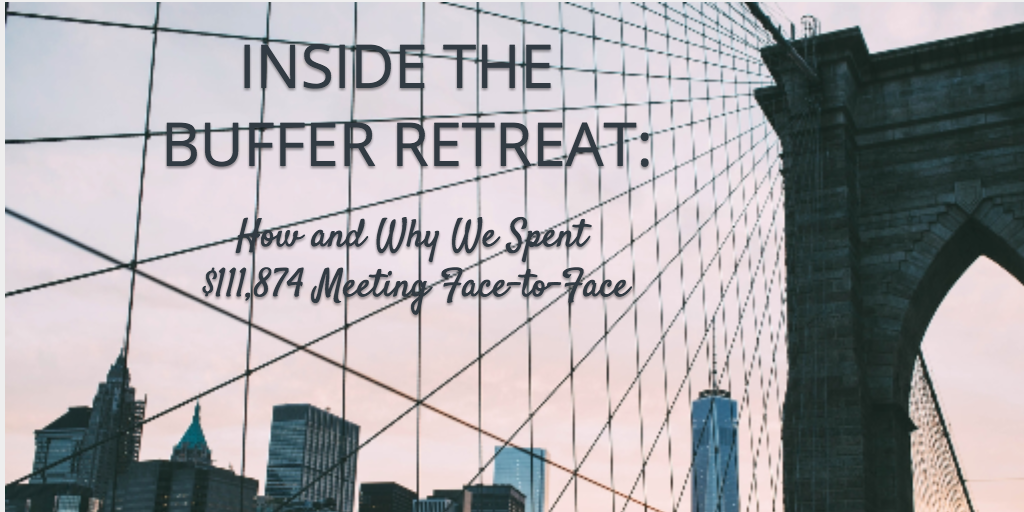
Where to go?
The first big question: Where should we go? This one is really fun to answer every 5 months. So far, the team has been to:
- Lake Tahoe
- Thailand
- South Africa
- New York
- Sydney
One thing that’s really neat about being a workplace with no managers is that retreats, too, happen organically. No one is particularly in charge of them, but some awesome leadership has emerged nonetheless.
Generally quite a few months in advance, one teammate will get the ball rolling by opening up a Doodle poll, Wufoo form or Google spreadsheet to pin down dates and location.
For our most recent retreat, Buffer’s fifth, you can see how the vote went as we decided to head to the beautiful city of Sydney.
First the location nominations:
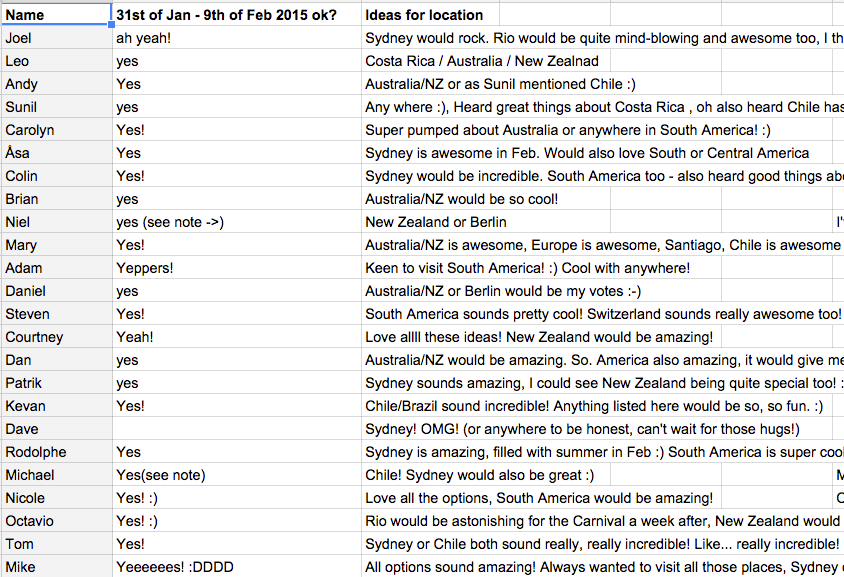
Then the vote:
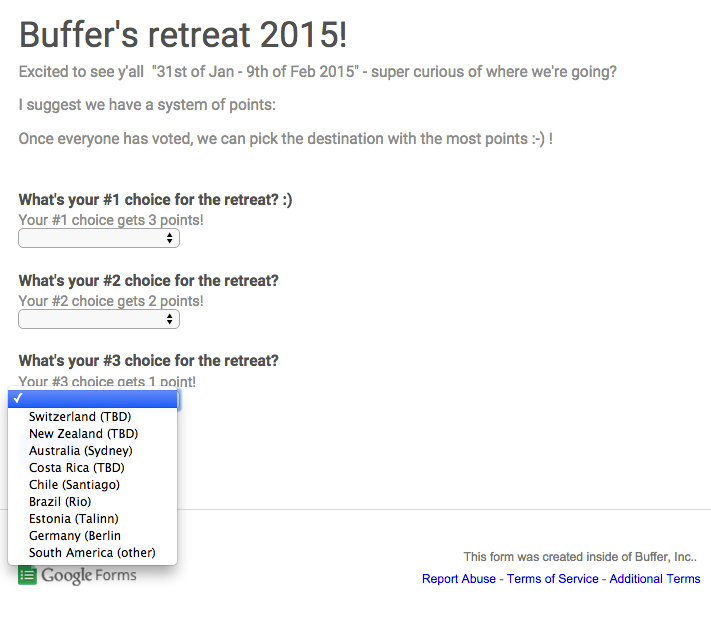
Tools that help us here: Wufoo, Google Drive, Doodle, Google Forms
Getting there
Booking airfare
Once the destination is settled (and a giant email thread of excitement ensues), all teammates are cleared to shop for their own plane ticket and expense it at their leisure.
We do this to give everyone the freedom to plan their own way here.
Some of us choose to travel before or after the retreat—for instance Joel and Brian spent a few weeks before the retreat traveling in Asia.
We give giant props to Hipmunk and our awesome team at Foresight for making the airfare and expense process easy!
Tools that help us here: Hipmunk, Hackpad for sharing flight and city details
Cost: About $2,200 per person, or $57,200 total
One note here: Teammates who are still in their 45-day trial period are not quite eligible for retreats until they finish up the 45 days and come on full time, which has led to some exciting close calls (Dan hopped aboard a plane to South Africa with less than a week’s notice!).
This time around we were able to meet two new teammates: Jose and Thomas!
Finding a place to stay
While we book our plane tickets, a few of amazing teammates begin to focus on where we’ll all stay once we arrive.
We have tried a few different types of accommodations on retreats. In Cape Town, we stayed all together in a few big houses, and I think Thailand might have been similar. In New York, mostly out of necessity, we switched to individual hotel rooms—and that carried on to Sydney as well.
Generally, we look for an affordable spot with great wifi. Breakfast is handy, too!
In Sydney we stayed in the Cambridge Hotel, where everyone was incredibly lovely and accommodating—especially on the day when we took over the hotel restaurant (and later, conference room) to work en masse answering customer tickets following a Google+ situation we accidentally created!
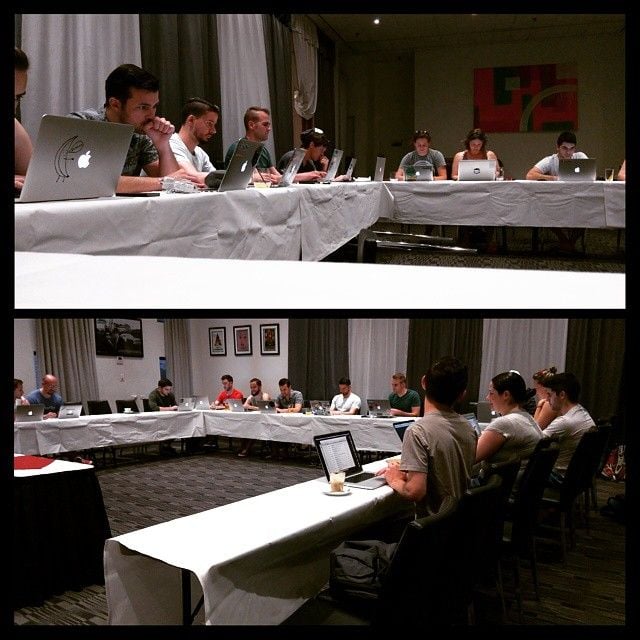
Tools that help us here: Google Sheets for sharing hotel info
Cost: $39,992
Where we work
A final piece of the puzzle is where we’ll all work when we get together.
In Cape Town, we simply made space around the common areas of our shared houses to get work done. (Poolside writing was nice!)
In New York, we made the switch to a coworking space near our hotel and really enjoyed the experience of working together at Chinatown’s Projective Space.
For our Sydney trip, we returned to the coworking scene and had an amazing week at Hub Sydney.
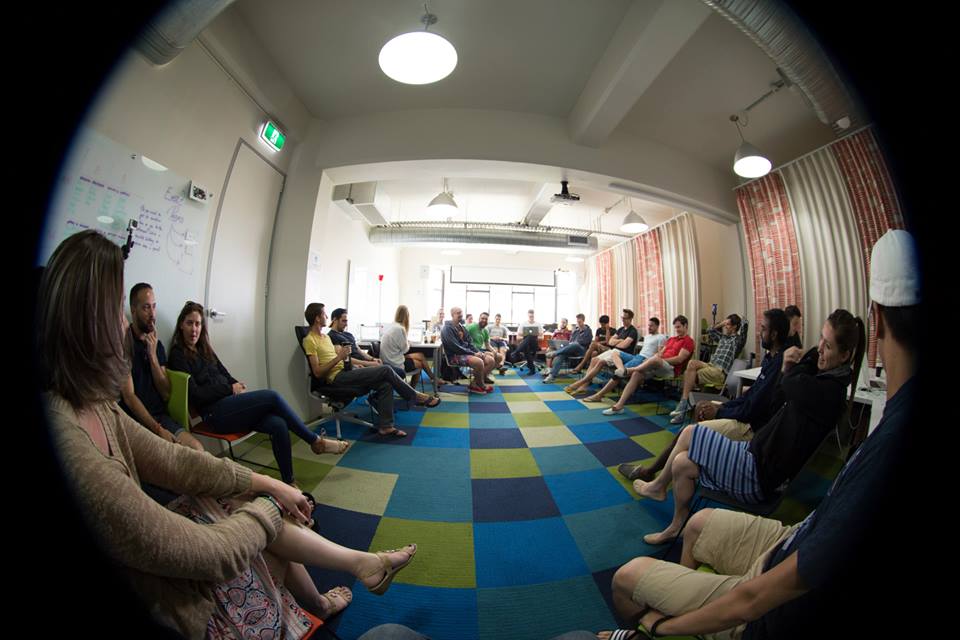
Getting a coworking space is an amazing luxury and does so much to make sure that we have time and space to fully connect with teammates even as we stay in individual hotel rooms. It also keeps us from overrunning hotel lobbies (though we still did a bit of that in Sydney) and generally gives us a big enough space to hold a meetup!
Cost: $3,510
Meeting the community
One of my very favorite things we’ve added to Buffer retreats beginning in New York last fall is the addition of a community meetup wherever we go.
Our community-focused teammates Nicole and Åsa did a killer job of planning this event in Sydney so that there were snacks, drinks, cool tunes, some Q & A time, Buffer swag, and plenty of new people to meet and greet.
Here’s a time-lapse look at the meetup fun:
Our big, big thanks to InVision for sponsoring our beer and cider!
Tools that help us here: Social media for getting the word out, Eventbrite for ticket management
Cost:
Drinks: AUD $835.56 (thanks, InVision!)
Food: AUD $1791.60
Other expenses: AUD $75
Swag: $180
Event space: AUD $688.88
Total: $2,816
Working together throughout the week
How we work together seems to be a bit different on every retreat. In Thailand (before my time), the group worked on one big project all week, from which Buffer for Business came!
In Cape Town, each team was focused on smaller projects, and we had daily stand-up meetings with all teammates each morning to share our progress.
In New York, the focus switched more to culture. In between regular work sessions, we had in-depth talks about topics like our values and how we might grow.
Having embraced a new philosophy of no managers, based on the book Reinventing Organizations, before our Sydney retreat, things took a different form once again as we tried a model that mimicked the Barcamp “unconference” vibe.
Anyone could sign up to lead a session or roundtable, and team members could attend as many or as few sessions as they liked. Topics ranged from happiness to side projects to CSS/HTML and how Buffer runs.
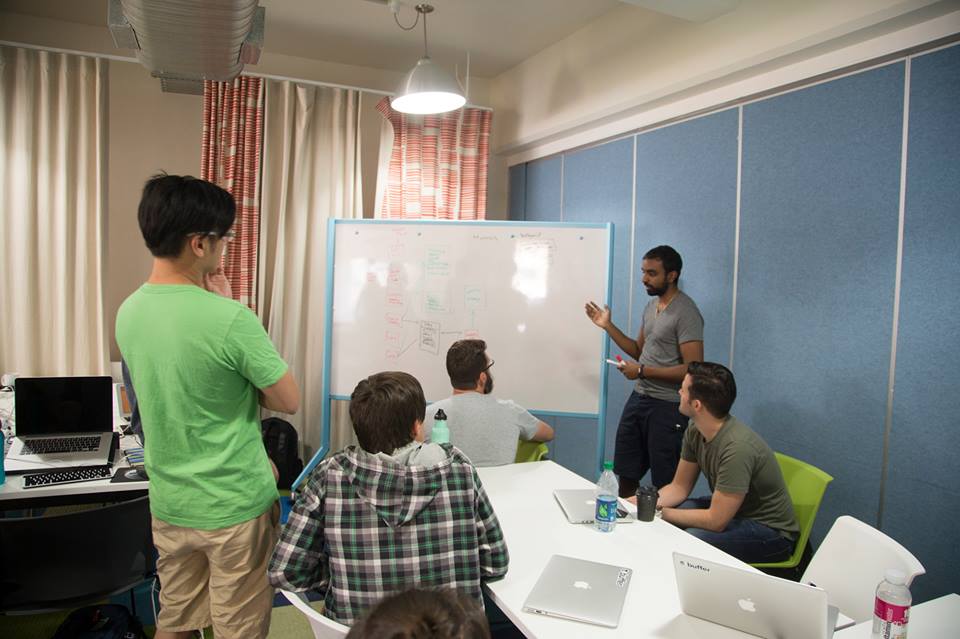
The general consensus here was that many of us felt slightly less productive than we normally would have been, but that the chance to talk and learn together in person and discuss ideas face-to-face more than made up for the deficit.
The “unconference” format proved to be a really cool concept that we might try to build upon for our next retreat—we’ve even considering opening up some of the sessions to the community or anyone who might be interested. What do you think?
Extras and fun stuff
It’s not all work and no play when we get together for Buffer retreats. We always try to make a good bit of time to hang out face-to-face and share lots of fun times together.
In Sydney, we got in heaps of amazing group activities, including a team dinner, a trip to Taronga Zoo (koalas!), taking in an amazing outdoor movie together, and a catamaran cruise along the Sydney Harbour.
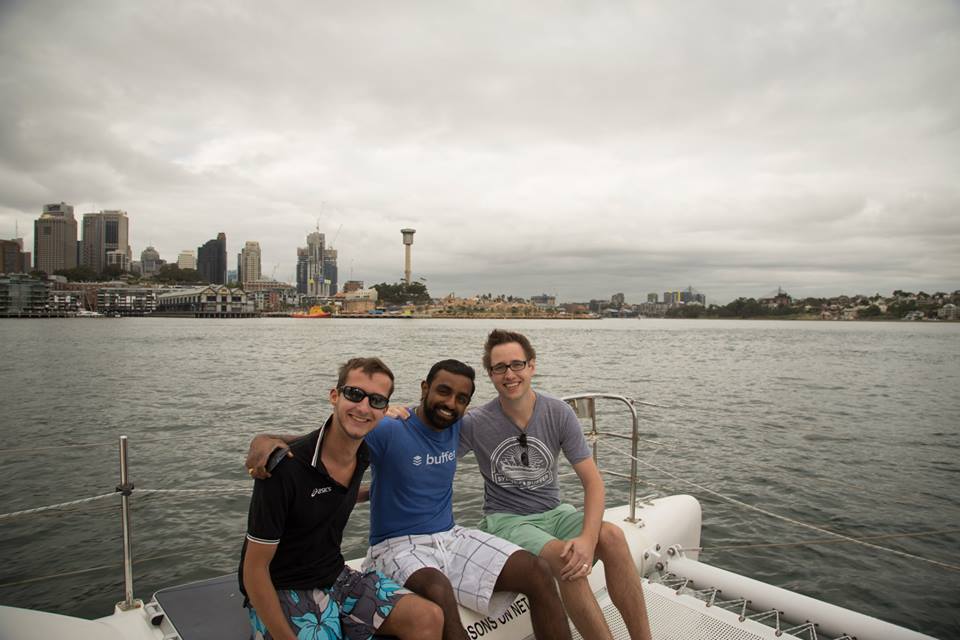
In keeping with the “unconference” theme, there were also other additional activities that team members could choose from, including climbing the Sydney Harbour Bridge, a piano concert at the Sydney Opera House and surf lessons on Bondi Beach.
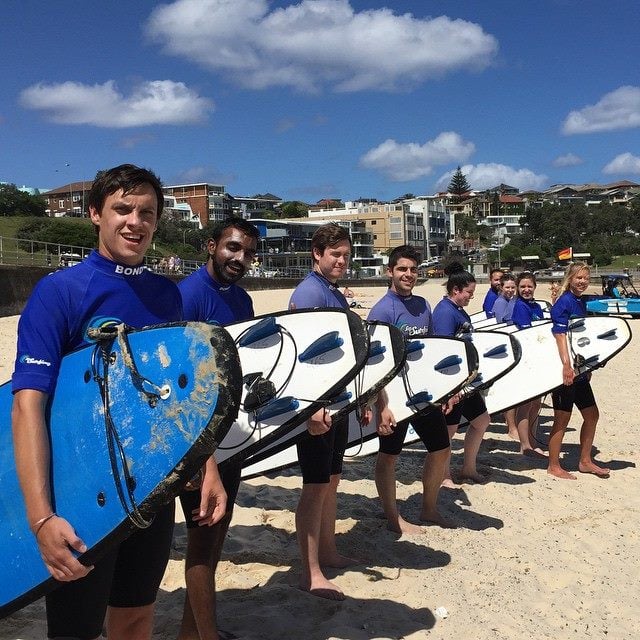
Tools that help us here: We use Facebook Messenger to keep up-to-date with everyone whereabouts and activities throughout the week
Costs:
Outdoor movie: AUD $992
Taronga Zoo: AUD $993
Catamaran cruise: AUD $1,200
Team dinner: AUD $2000
Lunch catering: AUD $403.40
Bridge climb: AUD $2728
Surf lessons: AUD $1360
Team T-shirts: AUD $1037.45
Total: $8,356
Grand total: $111,874
A quick note on additional costs: We tend to try to make retreats as “no cost” as possible for team members, since we all still pay rent/mortgages back home while we’re on them, and little things can quickly add up.
So anyone is free to expense a breakfast, a taxi ride, a SIM card, a dinner—whatever they feel is appropriate—throughout the week. In this way, the overall accounting here is a bit low, as individual reimbursement requests are still coming through for this latest trip.
What’s next?
Where will we go next? Who knows! The next retreat will be July-ish, and we’ve already begun preliminary voting and planning. It feels like a more remote, wintery type environment might be trending now. Here’s how the nominations are going so far:
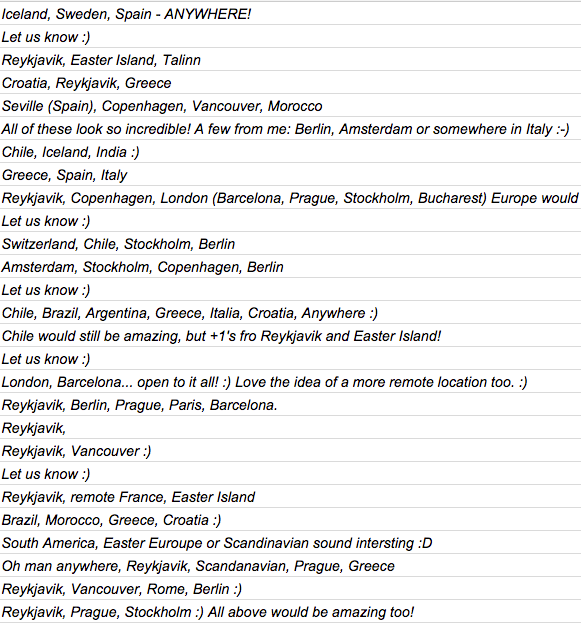
So that’s a bit of a look inside the retreat process for Buffer! I hope it might answer a few questions for you!
I also need to mention that Åsa and Rodolphe are our current retreat heroes and did so much, from accommodations to fun events, to make the Sydney retreat a once-in-a-lifetime memory.
Have you ever gone on a company retreat? What did you do, and how was the experience? I’d love to hear your feedback and tips as we begin planning our next journey.
Try Buffer for free
190,000+ creators, small businesses, and marketers use Buffer to grow their audiences every month.




